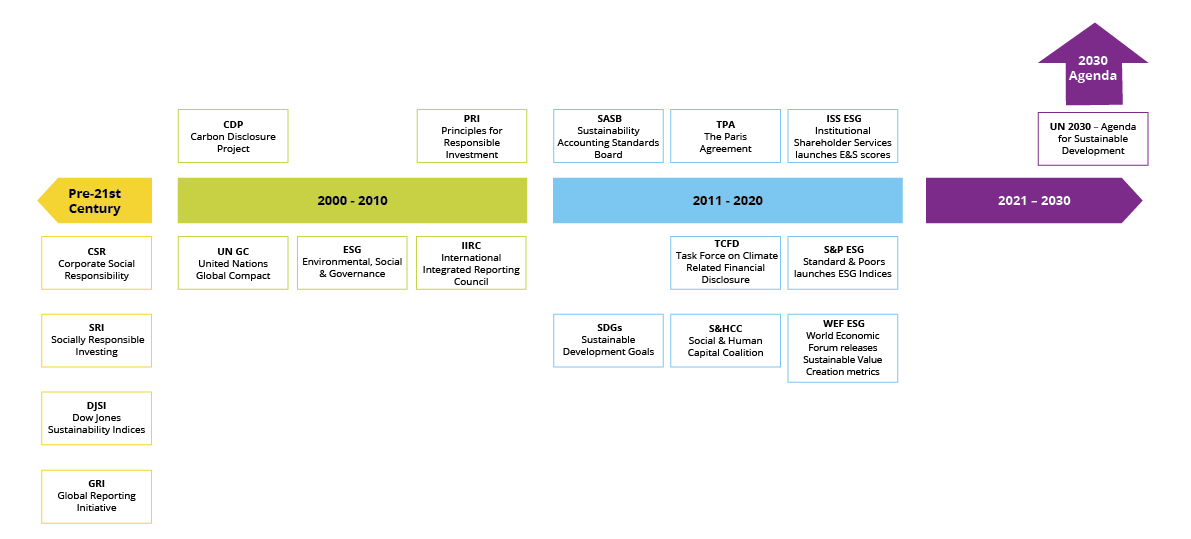The Decade of Action is Well Underway
The future of ESG – Sustainability can be traced to the earliest remnants of social responsibility; a maxim that frames an individual’s social obligation to act in ways that benefit society at large. For businesses, this responsibility exists as corporate social responsibility (CSR)—a self-regulating mechanism that assists organizations in being socially accountable to the public, their stakeholders, and themselves.
At the turn of the 21st century, sustainability as a movement was gathering steam on the back of landmark developments. These included socially responsible investing (SRI, the 1970s), the global reporting initiative (GRI, 1997), and the Dow Jones Sustainability Indices (DJSI, 1999).
As we embark on the second year of what the UN has coined the Decade of Action, the timeline below serves as a useful backdrop that charts the origins of Environment, Social, and Corporate Governance (ESG sector), as it highlights key milestones in the sustainability journey.
The piece that follows will function in support of our key takeaway: the future of ESG is here to stay. It is our belief that the movement will continue to gather steam. Organizations must prioritize socially responsible processes and the promotion of leadership that drives positive societal behaviors, particularly in response to GHG emissions and reducing the impact of climate change.
COVID-19: A Sustainability Wake-up Call
The pandemic that rocked the world was the major story of 2020, but the year was further punctuated by widespread unrest against other issues.
The aim of the Decade of Action is to meet the criteria set in the UN’s 2030 agenda and to move the world towards a series of universal, transformative goals that promote sustainability. Organizations and governments have been dragging their feet for far too long—commitments to sustainability have not been prioritized, and now future global and financial prosperity is at stake.
When ESG sector was coined in 2005, followed by the Sustainable Development Goals in 2015 to provide a framework for the future of ESG and sustainability efforts, the idea was that acute changes to everyday business dealings would fortify the longevity of the social and economic scapes for centuries to come. Instead, we are facing the counter-intuitiveness of the “more money now” attitude.
Where are we now?
The question becomes how to add validity to the future of ESG processes world leaders have already agreed to enact. There are no trickle-down processes between national governments and large corporations.
The 2015 Paris Agreement, with its primary goal of reducing GHG emission to help contain global temperature increase to below 2 degrees Celsius and minimize climate change impacts, was a necessary milestone. However, some observers believe that the pandemic will have knocked global sustainability efforts a decade behind the 2030 UN Agenda schedule. During the recent Abu Dhabi Sustainability Week Summit (ADSW), the UAE Minister of Industry and Advanced Technology and Special Envoy for Climate Change, Dr. Sultan bin Ahmed Al Jaber, aptly stated that “the COVID-19 pandemic was a wake-up call to humanity as a whole, and that it demonstrated the importance of sustainability in its broadest sense, revealing the interdependence between health and food and resource security.” A 2020 UN Emissions Gap Report concluded that despite a COVID-19-induced brief decline in emissions, the globe is headed towards an excess warming of 3 degrees Celsius by the end of the century.
At current, the changes we feel are small but noticeable. Population growth and climate change continue to exert pressure on the availability of water—a November 2020 report published by the Food and Agriculture Organization (FAO) stated that ≈1.2 billion people are experiencing high levels of water stress. The next month, the Chicago Mercantile Exchange (CME) launched futures contracts tied to the spot price of water in California, and the U.S. Pacific region reminded the world of the ugly effects of droughting when the area suffered the worst wildfire season on record, a year after Australia’s Black Summer cost the country $103 billion in damages.
What we are attempting to illustrate is that the eventuality of no return is inevitable unless the future of ESG sector is prioritized globally. The “more money now” frame of mind is limited in scope when there is an inability to source raw materials, there are deep supply chain inefficiencies, and limited capital to secure products.
A Look at the Current Situation
A study supported by the Energy Transitions Commission (ETC) in November 2019 stated that achieving decarbonization would require an intentionally coordinated approach organized by sector. The authors contend that the ten sectors—including the steel and cement industries, which account for 80% of global emissions—would require a series of technological revolutions.
Daniel Yergin, global energy expert and Pulitizer prize-winning author of The New Map: Energy, Climate, and the Clash of Nations (2020), asserts that substantial investments are required to support a low-carbon world as the infrastructure to allow one does not exist.
But the news is not all bad. In October 2020, Enel Group, which operates the largest power distribution network in the globe, published an update on its emissions targets, committing to an 80% reduction in GHG emissions by 2030, with the goal of hitting net-zero in 2050.
LafargeHolcim, the world’s leading cement producer, became a signatory to the Science Based Targets initiative (SBTi) in September 2020, pledging to its “Business Ambition for 1.5°C.” ArcelorMittal has also signed on with the SBTi in an attempt to define sustainability targets for the steel industry and reach net-zero emissions by 2050.
The above are but a few examples of the future of ESG that organizations leading their sectors toward sustainable practices. At the macro level, the progress is not so encouraging. But there is hope that businesses will take notice of the actions of their peers. Mining giant BHP committed to net-zero emissions by 2050 despite acknowledging that there is no existing technology that would allow them to decarbonize at that pace or scale. It is the sole message of the movement that has moved them to respond.
Finding Hope For the Future of ESG Sector and Net-Zero
Created in 2014, the SBTi—a collaboration between the Carbon Disclosure Project (CDP), World Resources Institute, the World Wide Fund for Nature, and the United Nations Global Compact—is on a mission to more precisely align companies’ GHG and sustainability goals with the global carbon budget. With over 1,100 companies engaged with the SBTi and the top 100 sustainable companies honored at this year’s Davos Agenda, there is hope that sustainability will one day attract a premium.
In his 2021 Letter to CEOs, BlackRock’s Larry Fink shared that the ESG sector is gaining momentum. In 2020, mutual funds and ETF investors invested $288 billion globally in sustainable assets, nearly doubling their 2019 investments.
But sustainability efforts and opportunities apply to more than just publicly traded companies, the concept is universal. We, at Proudfoot, believe that while a company is ultimately guided by its various stakeholders, customers, and internal hierarchy, there is always room for commitment for the future of ESG.
Proudfoot not only understands the importance of having an ESG vision but also has the know-how to operationalize it.
Three steps to operationalizing through the future of ESG
- Establish ESG direction at the Board level
- Fold ESG risk into enterprise risk management
- Integrate ESG into management models and operating models
In times of uncertainty, you need guaranteed results, so when you need a strategic partner for Business Value Creation while improving your ESG sector’s metrics, Proudfoot has the history, expertise, and track record to help you reach your goals.
“The pandemic was an existential threat to human health, in the same sense climate change is an existential threat to our planet’s health” – Larry Fink, Chairman & CEO of BlackRock
Download the Sustainable Projects guide to see how Proudfoot can help tackle a wide range of future of ESG project development goals that align with environmental, social, and governance best practices. This guide covers all 17 UN sustainable development goals and shows how Proudfoot is making a huge impact for clients on these important initiatives.


